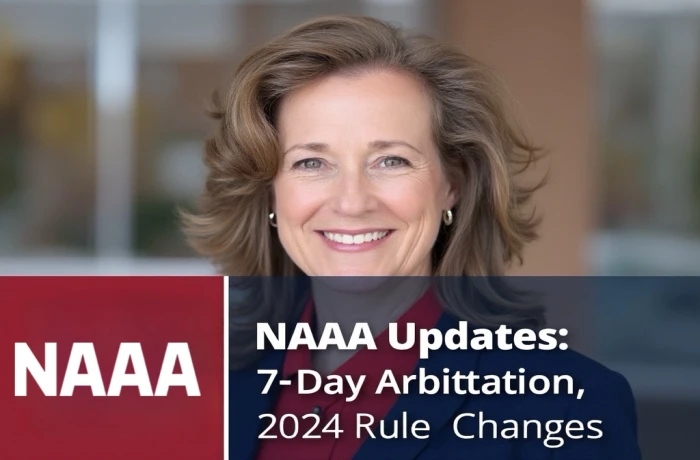7-Day Arbitration and More Key NAAA Rule Changes for 2024

Lila Claybourne
Nov 13, 2024

Summary:
Overview of the new NAAA 7-day arbitration rule.
Significant 2024 rule changes impacting vehicle condition reports, post-sale inspections, and electronic disclosures.
Benefits and challenges for buyers and sellers in auto auctions.
Best practices for adapting to these updates for both parties.
Introduction: Understanding the Latest NAAA Arbitration Updates
In the ever-evolving landscape of auto auctions, the National Auto Auction Association (NAAA) plays a pivotal role in maintaining transparency and fairness. Recent updates to NAAA’s arbitration policy, particularly the introduction of a 7-day arbitration window, reflect ongoing efforts to protect buyers and sellers from undisclosed issues and disputes.
These updates aren’t just minor tweaks — they represent significant changes to how the auto auction industry operates. From enhanced buyer protections to stricter seller obligations, these rule changes are poised to impact everyone involved in the auto auction ecosystem. In this article, we’ll explore the 7-day arbitration policy and the 2024 rule changes, offering a detailed guide on what they mean for buyers, sellers, and auto dealers alike.
What is the 7-Day Arbitration Policy?
One of the most prominent updates from NAAA is the extension of the arbitration window from a shorter period to a full 7 days. Under this new rule, buyers now have a longer timeframe to inspect their purchased vehicles and raise concerns if undisclosed damages or mechanical issues are found.
Key Features of the 7-Day Arbitration Rule:
Extended Inspection Period: Buyers have up to seven days to inspect vehicles and file arbitration claims for undisclosed damages or discrepancies.
Applicable to Various Claims: The rule applies to multiple arbitration categories, including undisclosed mechanical issues, frame damage, and post-sale inspection results.
Fairness in Disputes: It gives buyers more time to uncover hidden issues while ensuring sellers are held accountable for undisclosed problems.
Why This Matters for Buyers:
Traditionally, buyers had a limited window (often as short as 48 hours) to raise concerns after purchasing a vehicle. This short timeframe sometimes left buyers in a bind, especially for issues that weren’t immediately apparent. The new 7-day window provides more security for buyers, allowing for thorough inspections to be conducted without rushing the process.
Seller Considerations:
While this rule benefits buyers, it also means that sellers need to be more diligent in ensuring they disclose all known issues upfront. Sellers will now face a longer period of liability, and this can increase the chances of arbitration if any information is omitted or overlooked.
The 2024 Rule Changes: What’s New?
In addition to the 7-day arbitration rule, NAAA has introduced several significant changes for 2024 that both buyers and sellers must be aware of. These updates span various aspects of the auction process, from electronic disclosures to vehicle condition reports.
1. Post-sale Inspection Clarifications
In 2024, NAAA has provided clearer guidelines on what falls under the scope of post-sale inspections. This includes:
Expansion of Coverage: Additional components are now included in post-sale inspections, such as undisclosed frame damage and mechanical failures that aren’t disclosed at the time of sale.
Revised Claims Process: The post-sale inspection process has been streamlined to handle claims more efficiently, allowing disputes to be resolved faster.
Impact on Buyers and Sellers:
For Buyers: The clearer guidelines mean buyers can have a better understanding of what is covered and can act confidently when submitting arbitration claims for issues found during post-sale inspections.
For Sellers: Sellers must ensure that all critical details are disclosed upfront, as missing information could lead to a higher volume of arbitration claims under the updated post-sale inspection terms.
2. Electronic Sales Disclosures
As more auctions shift towards digital platforms, electronic sales have become increasingly common. NAAA’s 2024 rule changes address the growing need for clarity in these digital transactions.
Enhanced Disclosure Requirements: Sellers are now required to provide more detailed disclosures during electronic sales, ensuring that all relevant vehicle information is accurately presented before the auction concludes.
Digital Transparency: With more comprehensive electronic disclosures, buyers can make better-informed decisions, reducing the risk of post-purchase disputes.
Why This is Important:
Digital Transformation: The auto auction industry is rapidly adopting online auctions, and the need for transparency in these transactions is critical. By enforcing stricter disclosure standards for electronic sales, NAAA is helping to protect both buyers and sellers in this increasingly digital environment.
3. Stricter Vehicle Condition Report (VCR) Guidelines
The accuracy of Vehicle Condition Reports (VCRs) is critical in ensuring that buyers know exactly what they are bidding on. In 2024, NAAA is imposing stricter guidelines on the creation and use of VCRs.
Accountability for Accuracy: Sellers must ensure that all details in the VCR are accurate and truthful. Any discrepancies between the VCR and the actual condition of the vehicle can lead to arbitration.
Detailed Reporting: The updated rules encourage more detailed condition reporting, ensuring that any potential issues — from cosmetic damage to mechanical faults — are clearly outlined in the VCR.
Benefits for Buyers:
Greater Transparency: Buyers can have more confidence in the vehicles they purchase, knowing that sellers are held to stricter standards when providing VCRs.
Arbitration Rights: If there are significant discrepancies between the VCR and the actual vehicle, buyers can now pursue arbitration more easily under the updated guidelines.
The Impact of These Changes on the Auction Industry
The new NAAA rules, including the 7-day arbitration policy and 2024 updates, are designed to improve transparency, reduce disputes, and create a more balanced relationship between buyers and sellers. However, these changes bring both advantages and challenges to the industry.
For Buyers:
Increased Confidence: With the extended arbitration window and stricter vehicle condition reporting, buyers can make more informed decisions without feeling pressured.
Reduced Risk: Buyers can now thoroughly inspect vehicles post-sale, lowering the risk of discovering hidden issues after the purchase.
For Sellers:
More Stringent Requirements: Sellers now have a longer period of liability and must provide more detailed vehicle disclosures. This can increase the workload for sellers, who must ensure full transparency to avoid arbitration.
Potential for Increased Disputes: The longer arbitration window may lead to more claims, particularly if sellers do not fully comply with the updated rules.
Market Implications:
Overall, these changes are expected to foster greater trust between buyers and sellers in the auto auction space. By improving disclosure standards and extending the timeframe for resolving disputes, NAAA is aiming to create a more transparent and efficient market.
Benefits of the 7-Day Arbitration Rule
The introduction of the 7-day arbitration window offers several advantages for buyers and sellers alike, but it also changes how both parties must approach the auction process.
1. Increased Buyer Confidence
Buyers now have more time to inspect their vehicles, giving them peace of mind. With a full week to review their purchase, buyers are less likely to face unexpected issues after taking possession of the vehicle.
2. Seller Accountability
Sellers are now held accountable for any discrepancies or omissions that may surface during the extended arbitration window. While this may pose new challenges, it ultimately leads to a more transparent selling process, which benefits both parties in the long run.
3. Fair and Efficient Resolution of Disputes
The new arbitration framework is designed to streamline the dispute resolution process, allowing for faster and more efficient handling of claims. Buyers and sellers alike benefit from this, as disputes can be resolved without long, drawn-out proceedings.
Challenges for Sellers and How to Adapt
While the 7-day arbitration rule and 2024 changes are designed to protect buyers, they also place additional pressure on sellers. Here are some potential challenges sellers may face and strategies to adapt:
1. Increased Risk of Arbitration Claims
With the longer arbitration window, sellers may face more claims from buyers who discover issues after purchase. To mitigate this, sellers should:
Perform Thorough Pre-sale Inspections: Ensure that all mechanical, cosmetic, and frame-related issues are documented and disclosed upfront.
Provide Accurate VCRs: Take the time to create detailed and accurate Vehicle Condition Reports, as discrepancies could lead to arbitration.
2. Stricter Disclosure Standards
Sellers must now meet higher standards when it comes to providing information, especially in electronic sales. To stay compliant:
Double-Check Disclosures: Ensure that all disclosures, particularly in online transactions, are accurate and complete.
Use Technology to Your Advantage: Take advantage of digital tools to improve transparency and ensure all vehicle information is readily available.
What Auto Dealers Need to Know for 2024
Auto dealers participating in auctions need to be aware of how these rule changes will impact their operations. Dealers should focus on:
Compliance with New Disclosure Requirements: Ensure that all electronic sales and vehicle condition reports meet the updated standards.
Leverage Accurate Condition Reports: Using detailed VCRs not only helps avoid arbitration but also enhances buyer trust, leading to more successful sales.
Preparing for the Changes: Best Practices
For Buyers:
Take Full Advantage of the 7-Day Window: Use the extended arbitration period to thoroughly inspect the vehicle and ensure it meets your expectations.
Stay Informed: Familiarize yourself with the new rules, so you know your rights and can act quickly if any issues arise.
For Sellers:
Be Transparent: Full disclosure is key to avoiding arbitration. Make sure all relevant information is included in the vehicle condition report.
Stay Organized: Keep detailed records of all disclosures and vehicle inspections to protect yourself in case of arbitration claims. Ensuring that all documents are organized and accessible will help expedite the dispute resolution process, should it arise.
For Auto Dealers:
Educate Your Team: Ensure that your team is fully aware of the new NAAA rules and can effectively communicate these changes to potential buyers.
Embrace Digital Tools: Invest in technology that streamlines the sales and disclosure process, particularly for online auctions. This will not only help meet the new electronic sales disclosure requirements but also build buyer confidence.
Navigating the New NAAA Arbitration Landscape
The recent changes introduced by the NAAA, particularly the 7-day arbitration window and the 2024 rule updates, are a testament to the organization's commitment to creating a more transparent, fair, and buyer-friendly auction environment. While these changes offer enhanced protection for buyers, they also present new challenges for sellers, who must now adapt to stricter disclosure standards and a longer arbitration window.
For buyers, these updates mean greater confidence in their purchases, with more time to verify vehicle conditions and hold sellers accountable for any discrepancies. Sellers, on the other hand, need to be more diligent and transparent to avoid disputes, but by doing so, they can build trust with buyers and ensure smoother transactions.
As the auto auction industry continues to evolve, staying informed and compliant with NAAA’s updates will be crucial for all participants. Whether you're a buyer, seller, or auto dealer, these changes represent an opportunity to embrace transparency, improve trust, and enhance the overall auction experience.
If you're looking for a reliable auto transport service post-auction, AmeriFreight offers industry-leading vehicle shipping solutions to ensure that your purchased vehicles reach their destination safely and on time. For a fast, hassle-free quote, check out our instant quote calculator.
FAQs
1. What is NAAA’s 7-day arbitration rule? The 7-day arbitration rule allows buyers a full seven days to inspect a vehicle after purchase and file arbitration claims for any undisclosed damages or issues. This extension provides buyers with more time to thoroughly evaluate the vehicle before finalizing the sale.
2. What kinds of issues can be disputed under the 7-day arbitration rule? Buyers can dispute undisclosed mechanical issues, frame damage, and discrepancies found during post-sale inspections. If the vehicle’s condition differs significantly from the seller’s description or the Vehicle Condition Report (VCR), arbitration can be pursued.
3. How does the 2024 rule change affect electronic sales? The 2024 updates impose stricter requirements on electronic sales disclosures. Sellers must ensure that all relevant vehicle details are accurately represented during online auctions, helping buyers make informed decisions.
4. What are the new guidelines for Vehicle Condition Reports (VCRs)? The new rules require that VCRs be more detailed and accurate. Sellers are held accountable for any discrepancies between the condition described in the VCR and the actual condition of the vehicle. This protects buyers from purchasing vehicles that have hidden issues.
5. How should sellers prepare for these rule changes? Sellers should focus on performing thorough pre-sale inspections, providing accurate and comprehensive VCRs, and ensuring all necessary disclosures are made, especially during electronic sales. Being transparent and organized will help sellers avoid arbitration claims.
6. What impact will these rule changes have on auto dealers? Auto dealers must ensure compliance with the updated NAAA rules, particularly when it comes to disclosure requirements for electronic sales. Dealers should also make use of technology to streamline their sales processes and enhance transparency.
7. How do these changes benefit buyers? Buyers gain more time to inspect their purchases, reducing the risk of unforeseen issues. The stricter VCR guidelines and extended arbitration window give buyers greater protection and confidence in their purchases.
8. What happens if a seller fails to meet the new disclosure requirements? If a seller fails to meet the new disclosure requirements, particularly in electronic sales or VCR accuracy, buyers may file arbitration claims. Sellers who consistently fail to comply with these rules may face more frequent arbitration disputes and potentially reputational damage.
9. Can I still pursue arbitration after the 7-day window has closed? In most cases, arbitration claims must be filed within the 7-day window. However, if certain severe issues arise that were not reasonably detectable within that timeframe, exceptions may apply. Always check with the NAAA guidelines for specific cases.
10. How can AmeriFreight help with post-auction vehicle transport? AmeriFreight offers reliable, safe, and timely vehicle transport services for buyers and sellers post-auction. With competitive rates and excellent customer service, AmeriFreight ensures your vehicles are transported with care. You can get a quick quote here.
By staying ahead of these NAAA changes and adopting best practices for compliance, buyers and sellers alike can navigate the evolving auction landscape with confidence.
Related Posts
















